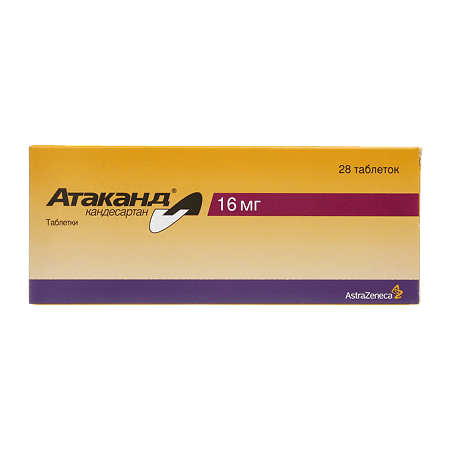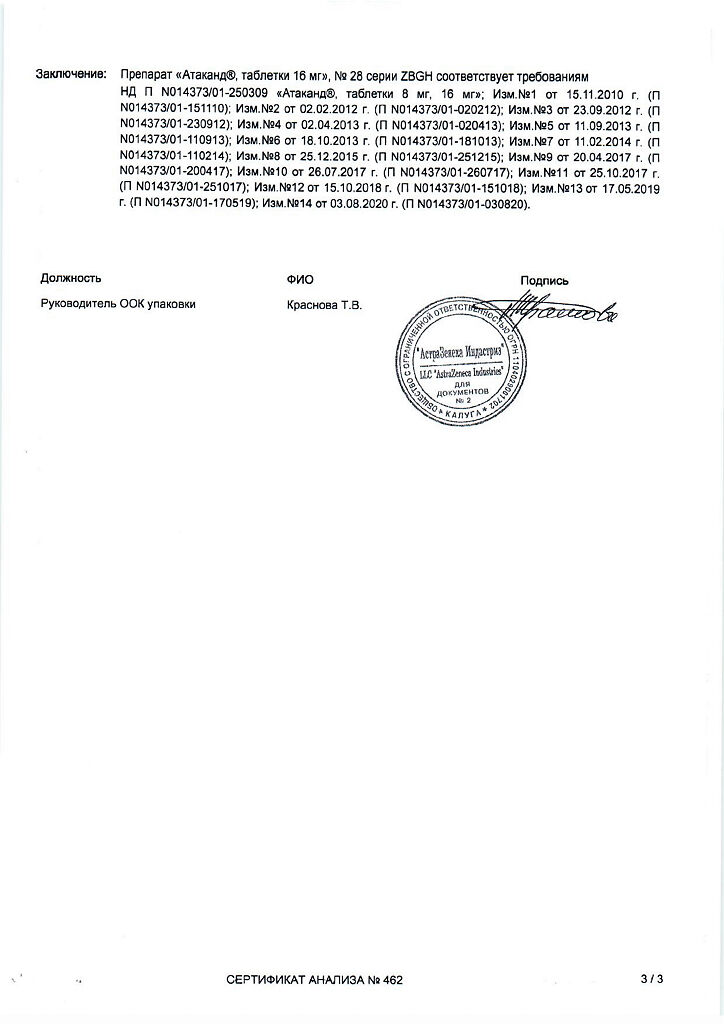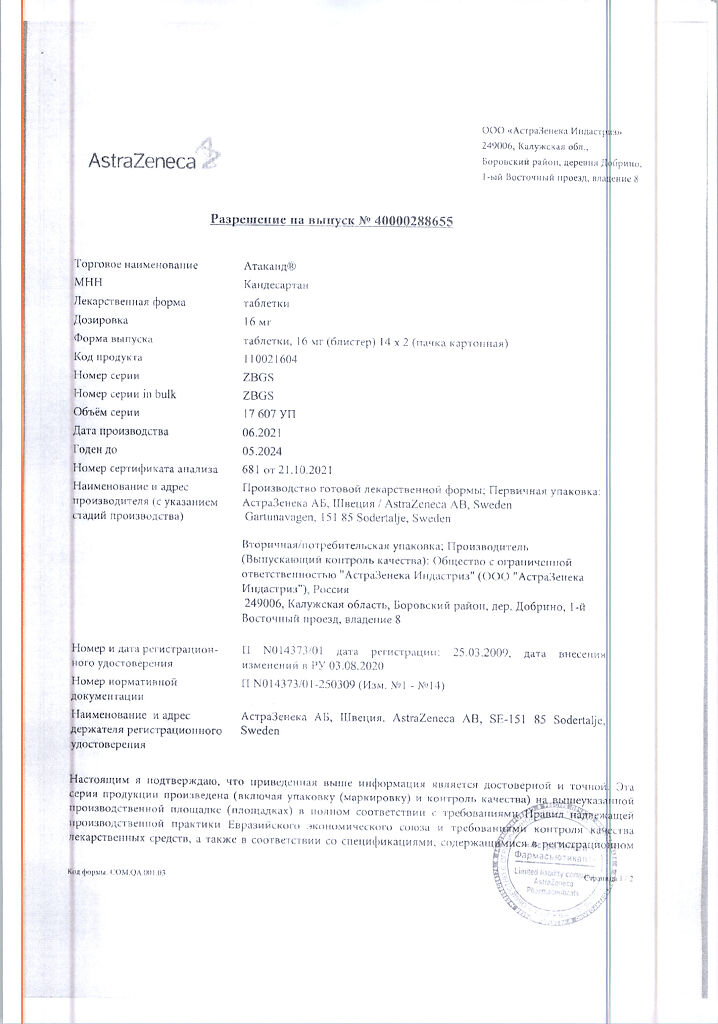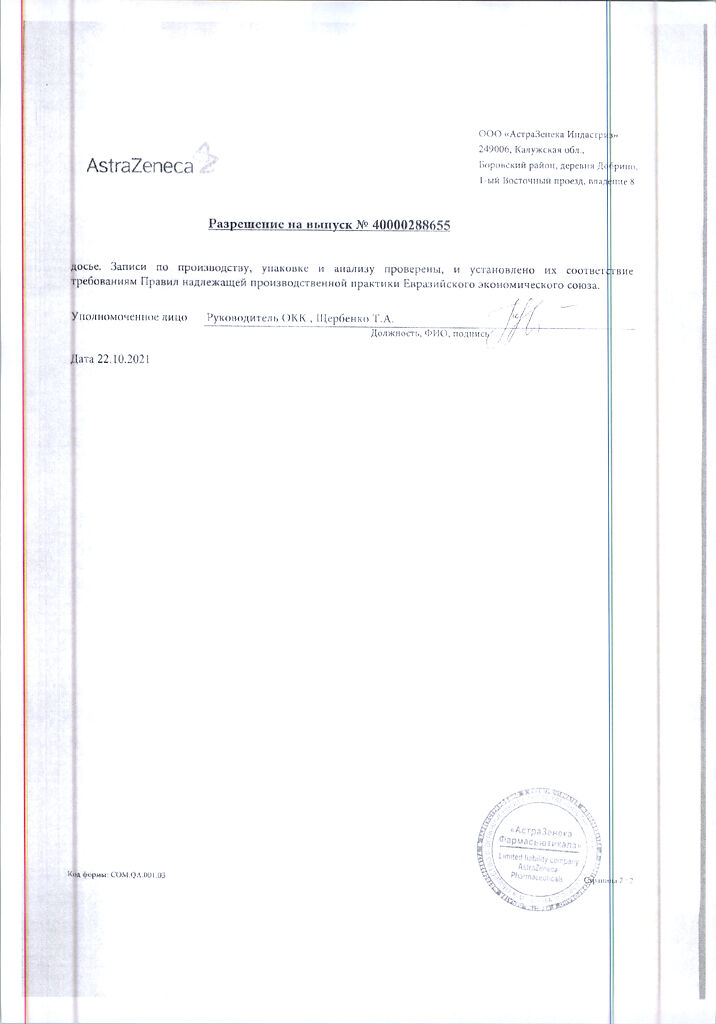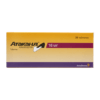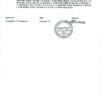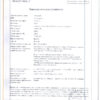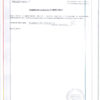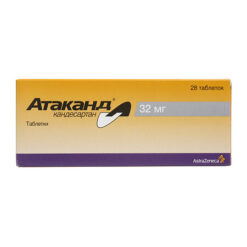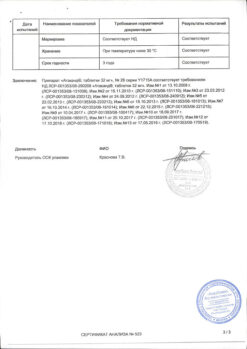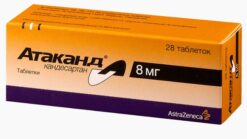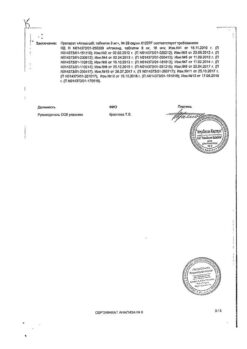No products in the cart.
Atakand, tablets 16 g mg 28 pcs
€79.67 €66.39
Description
Pharmacotherapeutic group: angiotensin II receptor antagonist.
ATX code: C09CA06
Pharmacological properties
Indications
Indications
Active ingredient
Active ingredient
Composition
Composition
Active ingredient:
candesartan cilexetyl 16 mg.
Auxiliary substances:
Calcium carmellose (carmellose calcium salt) 5.6 mg,
hyprolose (hydroxypropyl cellulose) 4.0 mg,
Iron oxide red dye E 172 0.26 mg;
Lactose monohydrate 81.4 mg,
Magnesium stearate 0.4 mg,
Corn starch 20.0 mg,
Macrogol 2.6 mg.
How to take, the dosage
How to take, the dosage
Atacand® should be taken once daily regardless of meals.
Hypertension
The recommended starting and maintenance dose of Atacand® is 8 mg once daily.
Patients who require further reduction of BP are recommended to increase the dose to 16 mg once daily.
The maximum antihypertensive effect is achieved within 4 weeks of starting treatment.
If therapy with Atacand® does not lower BP to optimal levels, it is recommended to add a thiazide diuretic to therapy.
Patients in the elderly
In elderly patients, there is no need to adjust the initial dose of the drug.
Patients with impaired renal function
In patients with mild to moderate renal impairment (creatinine clearance 30-80 ml/min), including patients on hemodialysis, the starting dose of the drug is 4 mg (1/2 tablet of 8 mg). The dose should be titrated depending on the therapeutic effect of the drug.
The clinical experience with the drug in patients with severe renal dysfunction or terminal renal failure (creatinine clearance less than 15 ml/min) is limited.
Patients with hepatic impairment
In patients with mild to moderate hepatic impairment, a daily dose of 4 mg once daily (1/2 tablet of 8 mg) is recommended to start therapy. It is possible to increase the dose if necessary. Atacand® is contraindicated in patients with severe liver dysfunction and/or cholestasis.
Companion therapy
The use of Atacand® together with thiazide-type diuretics (e.g. hydrochlorothiazide) may increase the antihypertensive effect of Atacand®.
Chronic heart failure
The recommended starting dose of Atacand® is 4 mg (‘L 8 mg tablets) once daily. Increase the dose to 32 mg once daily or to the maximum tolerated dose by doubling it at intervals of at least 2 weeks.
Patients in special groups
Patients who are elderly and those with impaired renal or hepatic function do not need to change the starting dose of the drug.
Periatric and adolescent use
The safety and effectiveness of Atacand® in children and adolescents (
Interaction
Interaction
In interaction with other medicinal products and other forms of drug interactions
In pharmacokinetic studies, co-administration of Atacand with hydrochlorothiazide, warfarin, digoxin, oral contraceptives (ethinylestradiol/levonorgestrel), glibenclamide, nifedipine and enalapril has been studied. No clinically significant drug interactions have been identified.
Candesartan is slightly metabolized in the liver (CYP2C9). The conducted studies on interaction showed no effect of the drug on CYP2C9 and CYP3A4, the effect on other isoenzymes of cytochrome P450 system has not been studied.
The co-administration of Atacand with other antihypertensive agents potentiates the hypotensive effect.
The experience with other drugs acting on the renin-angiotensin-aldosterone system shows that concomitant therapy with potassium-saving diuretics, potassium preparations, salt substitutes containing potassium, and other agents that may increase serum potassium levels (e.g., heparin) may lead to hyperkalemia.
When lithium preparations are coadministered with ACE inhibitors, reversible increase in serum lithium concentration and development of toxic reactions have been reported. Similar reactions can occur when using angiotensin II receptor antagonists, therefore, it is recommended to monitor serum lithium levels when combining use of these drugs.
The bioavailability of candesartan is not dependent on food intake.
Special Instructions
Special Instructions
Renal dysfunction
Atacand®, as well as other drugs affecting or acting on the renin-angiotensin-aldosterone system, renal dysfunction may be observed in some patients.
When using Atacand® in patients with arterial hypertension and severe renal insufficiency (creatinine clearance less than 30 ml/min), it is recommended to monitor potassium and creatinine serum concentrations periodically. Clinical experience of using the drug in patients with severe renal impairment or terminal renal failure (creatinine clearance less than 15 ml/min) is limited. Such patients should cautiously titrate the dose of Atacand® under close control of BP.
In patients with chronic heart failure, renal function should be monitored periodically, especially in patients aged 75 years and older and in patients with impaired renal function. When increasing the dose of Atacand®, it is also recommended that potassium and creatinine concentrations be monitored.
The clinical studies of Atacand® in chronic heart failure did not include patients with creatinine concentration > 265 µmol/L (> 3 mg/dL).
Combined use with ACE inhibitors in chronic heart failure
The use of candesartan in combination with ACE inhibitors may increase the risk of adverse effects, especially renal dysfunction and hyperkalemia. In these cases, close monitoring and control of laboratory parameters are necessary.
Renal artery stenosis
In patients with bilateral renal artery stenosis or artery stenosis of the single kidney, drugs that affect the renin-angiotensin-aldosterone system, particularly ACE inhibitors, may cause increased serum urea and creatinine concentrations.
Similar effects can be expected with angiotensin P receptor antagonists.
Kidney transplantation
The clinical experience with Atacand® in kidney transplant patients is limited.
Arterial hypotension
Atacand® therapy may cause arterial hypotension in patients with chronic heart failure. As with other drugs acting on the renin-angiotensin-aldosterone system, the reason of arterial hypotension in patients with arterial hypertension may be the decrease of circulating blood volume, as observed in patients receiving high doses of diuretics. Therefore, caution should be exercised at the beginning of therapy and correction of hypovolemia should be performed, if necessary.
Double blockade of the renin-angiotensin-aldosterone system when using drugs containing aliskiren
Double blockade of the renin-angiotensin-aldosterone system by combining candesartan cilexetil and aliskiren is not recommended due to increased risk of arterial hypotension, hyperkalemia, and altered renal function.
The use of candesartan cilexetil in combination with aliskiren is contraindicated in patients with diabetes mellitus (type 1 or 2) or with moderate or severe renal impairment (GFR) General anesthesia and surgery
Patients receiving anesthesia and surgeryp> Patients receiving angiotensin II antagonists may develop arterial hypotension during general anesthesia and surgical procedures as a result of blockade of the renin-angiotensin-aldosterone system. Very rarely there may be cases of severe arterial hypotension requiring intravenous administration of plasma substitute solutions and/or vasopressors.
Aortic and mitral valve stenosis or hypertrophic obstructive cardiomyopathy
When Atacand® is prescribedas well as other vasodilators, caution should be exercised in patients with hypertrophic obstructive cardiomyopathy or hemodynamically significant aortic or mitral valve stenosis.
Primary hyperaldosteronism
Patients with primary hyperaldosteronism are usually resistant to therapy with hypotensive drugs affecting the renin-angiotensin-aldosterone system. Therefore, Atacand® is not recommended for administration in these patients.
Hyperkalemia
The clinical experience with other drugs affecting the renin-angiotensin-aldosterone system shows that concomitant administration of Atakand® with potassium-saving diuretics, potassium preparations or salt substitutes containing potassium or other drugs that may increase potassium content in blood (e.g., heparin) may lead to the development of hyperkalemia in patients with arterial hypertension. Patients with chronic heart failure during therapy with Atakand® may develop hyperkalemia. When Atacand® is administered to patients with chronic heart failure, regular monitoring of potassium in blood is recommended, especially when combined with ACE inhibitors and potassium-saving diuretics.
General
. Patients in whom vascular tone and renal function are predominantly dependent on the activity of the renin-angiotensin-aldosterone system (e.g., patients with severe chronic heart failure or renal disease, including renal artery stenosis) are particularly sensitive to drugs acting on the renin-angiotensin-aldosterone system. Prescription of such drugs is accompanied in these patients by acute arterial hypotension, azotemia, oliguria and, less frequently, acute renal failure.
The possibility of these effects cannot be excluded with the use of angiotensin II receptor antagonists. Sharp decrease of BP in patients with coronary heart disease or cerebrovascular diseases of atherosclerotic genesis while using any hypotensive agents may lead to myocardial infarction or stroke.
Impact on ability to drive or operate machinery
Impact on ability to drive or operate machinery has not been studied, but pharmacodynamic properties of the drug indicate that there is no such effect.
Driving and engaging in potentially hazardous activities requiring increased concentration and quick psychomotor reactions should be noted that dizziness and increased fatigue may occur with the use of the drug.
Contraindications
Contraindications
With caution: In patients with severe renal insufficiency (creatinine clearance less than 30 ml/min), bilateral renal artery stenosis or artery stenosis of the single kidney, with hemodynamically significant aortic and mitral valve stenosis, after a history of renal transplantation, in patients with cerebrovascular disease and coronary heart disease (CHD), hyperkalemia, in patients with reduced circulating blood volume, with primary hyperaldosteronism (not enough data on clinical studies), hypertrophic obstructive cardiomyopathy.
Side effects
Side effects
CNS disorders: often (more than 2%) – headache, dizziness.
Laboratory parameters: increase in AST activity (slightly higher than in the groups taking placebo). In general, there were no clinically significant changes in laboratory parameters when taking Atacand.
Others: often (more than 2%) – back pain.
The clinical trials showed good tolerability of the drug, the incidence of side effects was comparable to placebo, it did not depend on the dose of the drug, as well as on the age and sex of the patient. In general, the side effects were moderate and temporary. The number of drug discontinuation cases due to side effects was similar to that of the candesartan cilexetil and placebo groups.
A causal relationship between Atacand administration and the side effects described has not been established.
Overdose
Overdose
Pregnancy use
Pregnancy use
Pregnancy
The use of Atacand® during pregnancy is contraindicated (see section “Contraindications”). Patients taking Atacand® should be advised of this prior to planning a pregnancy so that they can discuss alternative therapeutic options with their physician.
If pregnancy is diagnosed, therapy with Atacand® should be discontinued immediately and alternative therapy should be prescribed if necessary.
Drugs with a direct effect on the renin-angiotensin-aldosterone system may disrupt fetal development or have adverse effects on the newborn, up to and including death, if used during pregnancy.
It is known that therapy with angiotensin II receptor antagonists can cause fetal growth disorders (impaired renal function, oligohydramnios, delayed cranial ossification) and complications in the newborn (renal failure, arterial hypotension, hyperkalemia).
Breast-feeding period
It is currently unknown whether candesartan penetrates into breast milk. However, candesartan is excreted in the milk of lactating rats. Due to possible adverse effects on infants, Atacand® should not be used during breastfeeding.
Atacand® should not be used during breastfeeding.
Similarities
Similarities
Additional information
| Weight | 0.017 kg |
|---|---|
| Shelf life | 3 years |
| Conditions of storage | At temperatures below 30 °C |
| Manufacturer | AstraZeneca AB, Sweden |
| Medication form | pills |
| Brand | AstraZeneca AB |
Other forms…
Related products
Buy Atakand, tablets 16 g mg 28 pcs with delivery to USA, UK, Europe and over 120 other countries.

